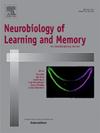Effects of maternal separation on punishment-driven risky decision making in adolescence and adulthood
IF 1.8
4区 心理学
Q3 BEHAVIORAL SCIENCES
引用次数: 0
Abstract
Early life adversity (ELA) is associated with a multitude of neural and behavioral aberrations. To develop treatments to mitigate the effects of ELA, it is critical to determine which aspects of cognition are affected and when these disturbances manifest across the lifespan. Here, we tested the effects of maternal separation, an established rodent model of ELA, on punishment-driven risky decision-making longitudinally in both adolescence (25–55 days old) and adulthood (80–100 days old). Risk-taking was assessed with the Risky Decision-making Task, wherein rats choose between a small, safe reward and a large reward accompanied by an escalating risk of punishment (foot shock). We observed that rats exposed to maternal separation were more prone to risk-taking than controls during adolescence, and demonstrated reduced latency to make both risky and safe decisions. Interestingly, this augmented risk-taking was no longer evident in adulthood. Males and females displayed comparable levels of risk-taking during adolescence then diverged in adulthood, with adult males displaying a sharp increase in risk-taking. Finally, we observed that risk-taking changed across the lifespan in rats exposed to maternal separation, but not in control rats. Collectively, these data reveal that ELA engenders risk-taking in adolescence but not adulthood, and that sex differences in risky decision-making are not evident until adulthood. This has important implications for the development of both behavioral and biological treatments to improve decision-making during the vulnerable adolescent period.
母亲分离对青少年和成年期惩罚驱动的风险决策的影响。
早期生活逆境(ELA)与许多神经和行为失常有关。为了开发减轻ELA影响的治疗方法,确定认知的哪些方面受到影响以及这些障碍在一生中何时表现出来是至关重要的。在这里,我们测试了母亲分离(一种已建立的ELA啮齿动物模型)对青春期(25-55 天大)和成年期(80-100 天大)惩罚驱动的风险决策的影响。通过风险决策任务评估风险,其中大鼠在小而安全的奖励和伴随着惩罚风险升级的大奖励(足部电击)之间做出选择。我们观察到,暴露于母亲分离的大鼠在青春期比对照组更倾向于冒险,并且表现出做出风险和安全决策的延迟时间缩短。有趣的是,这种增强的冒险行为在成年后不再明显。男性和女性在青春期表现出相当水平的冒险行为,然后在成年期出现分化,成年男性的冒险行为急剧增加。最后,我们观察到,暴露于母亲分离的大鼠的冒险行为在整个生命周期中都发生了变化,而对照组则没有。总的来说,这些数据表明,ELA在青春期产生冒险行为,而不是成年期,并且在风险决策方面的性别差异直到成年期才明显。这对行为和生物学治疗的发展具有重要的意义,可以改善青少年时期的决策能力。
本文章由计算机程序翻译,如有差异,请以英文原文为准。
求助全文
约1分钟内获得全文
求助全文
来源期刊
CiteScore
5.10
自引率
7.40%
发文量
77
审稿时长
12.6 weeks
期刊介绍:
Neurobiology of Learning and Memory publishes articles examining the neurobiological mechanisms underlying learning and memory at all levels of analysis ranging from molecular biology to synaptic and neural plasticity and behavior. We are especially interested in manuscripts that examine the neural circuits and molecular mechanisms underlying learning, memory and plasticity in both experimental animals and human subjects.

 求助内容:
求助内容: 应助结果提醒方式:
应助结果提醒方式:


